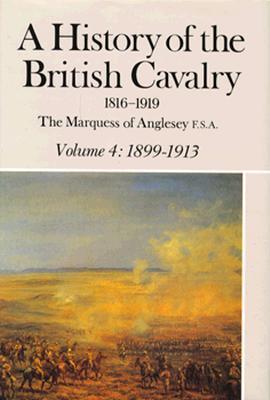

 |

|

The average rating for History of the British Cavalry 1816-1919 1899-1913 based on 2 reviews is 4.5 stars.
Review # 1 was written on 2015-05-24 00:00:00 Mina Roditis Mina RoditisThe second volume of the seventh Marquess of Anglesey’s history of the British cavalry begins with the “Camp of Exercise” at Chobham in 1853. The brainchild of the late Duke of Wellington, it was a forerunner of the sort of the military exercises that are commonplace today but were a novelty back then. As Anglesey notes, the exercise highlighted several problems with the cavalry, yet efforts to address them were quickly overtaken by events. In that respect, the Chobham exercise serve as a fitting precursor of the two decades that were to follow, as a branch still immersed in their Napoleonic-era procedures and routines was about to undergo considerable change. The driving force for this change was service in the field. Though Anglesey describes cavalry operations in a half-dozen conflicts over the course of the two decades covered in his book, the era was dominated by two events in particular. The first of these was the Crimean War, during which the cavalry found itself deployed to the other end of Europe in extraordinary adverse conditions. His narrative is an account of adaptation, improvisation, and bruised egos. Few of the cavalry commanders involved emerged with their reputations enhanced, with Lord Lucan’s conduct proving particularly undistinguished. Though the war lasted for three years, the major battles involving the cavalry – most notably the battle of Balaclava with its famed “Charge of the Light Brigade” – were waged in its first part, leaving the units deployed serving in a supporting role for the final year and a half of the conflict. Attempts to addresses the lessons of the conflict were forestalled by the other major deployment of the period, which was to India in response to the “Great Mutiny.” Here Anglesey’s text is particularly dated, as his language exposes his pro-imperial perspective on the uprising. The conflict against the groups that challenged British rule required months of operations before it was resolved. Anglesey describes both these operations and the post-Mutiny integration of East India Company cavalry units into the British Army, which proved controversial for many of the men involved and took longer to complete than the Mutiny itself. After covering the various operations Anglesey shifts his focus to describing the lives of the officers and men who served in the branch. Much as in the first volume, it’s a tale of parsimony-induced hardship, with low pay and inadequate living conditions the norm for most of the lower ranks. Yet throughout the period reforms were introduced to address many of these concerns, with their gradual implementation slowly improving the lot of the men. Anglesey is particularly good at describing the complex transactions involving the selling and purchasing of commissions, a practice soon to be reformed out of existence. Nor does he neglect the horses themselves, as he addresses the breeds use, their stabling, and the burdens placed upon them by the men. It adds an important level of detail that is one of the great strengths of Anglesey’s work. By the end of the book, Anglesey has detailed for his readers a cavalry arm that had undertaken much needed reforms that maintained its value on the battlefield while improving conditions for the men who served in it. Throughout its pages he demonstrates the same passion for his subject that was evident in his first volume, which is reflected in the depth of his knowledge and his respect for the men about whom he writes. While his description of the campaigns suffers from an exclusionary focus that can leave out background about the infantry and artillery that would have been helpful for an overall understanding of the battles on which he focuses, this doesn’t detract from his overall success in providing a masterful study of the British cavalry in an era of increasing change. |
Review # 2 was written on 2009-12-04 00:00:00 Misty Acheson Misty AchesonFrom a class taught by one of the most dynamic and determined teachers I've ever met. R.I.P Dr. Bryner...we'll keep championing the environment in your memory. |
CAN'T FIND WHAT YOU'RE LOOKING FOR? CLICK HERE!!!